 W
WAgony in the Garden is a small 1524 oil on panel painting of the Agony in the Garden by Correggio, now at Apsley House in London.
 W
WThe Baptism of Constantine is a painting by assistants of the Italian Renaissance artist Raphael. It was most likely painted by Gianfrancesco Penni, between 1517 and 1524.
 W
WThe Battle of the Milvian Bridge, or The Battle at Pons Milvius, is a fresco in one of the rooms that are now known as the Stanze di Raffaello, in the Apostolic Palace in the Vatican depicting the Battle of the Milvian Bridge.
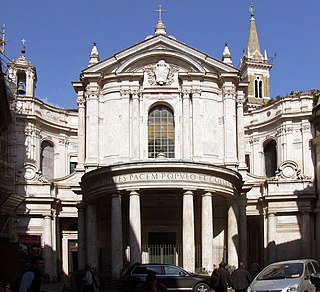 W
WSanta Maria della Pace is a church in Rome, central Italy, not far from Piazza Navona. The building lies in rione Ponte.
 W
WThe Donation of Constantine or Donation of Rome is a painting by assistants of the Italian renaissance artist Raphael. It was most likely painted by Gianfrancesco Penni or Giulio Romano, somewhere between 1520 and 1524. After the master's death in 1520, they worked together with other members of Raphael's workshop to finish the commission to decorate with frescoes the rooms that are now known as the Stanze di Raffaello, in the Apostolic Palace in the Vatican. The Donation of Constantine is located in the Sala di Costantino. It was inspired by the famous forged documents that supposedly granted the Popes sovereignty over Rome's territorial dominions.
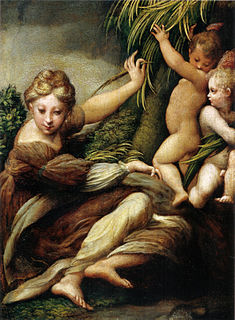 W
WFemale Martyr with Two Angels is a c.1523-1524 oil on panel painting by Parmigianino, now in the Städel Museum in Frankfurt, to which it was donated in 1913 by Baroness Emilie Margarethe Beaulieu-Marconnay, member of a family of bankers and art patrons in the city.
 W
WLament over the Dead Christ is a 1524 or 1525 oil on canvas painting by Andrea Previtali, produced for the church of Sant’Andrea, Bergamo, where it still hangs.
 W
WThe Lamentation of Christ is an oil on canvas painting by the Italian Renaissance artist Correggio, dating from around 1524 and housed in the Galleria Nazionale of Parma, Italy.
 W
WThe Martyrdom of Four Saints is an oil on canvas painting by the Italian Renaissance artist Correggio, dating from around 1524 and housed in the Galleria Nazionale of Parma, Italy.
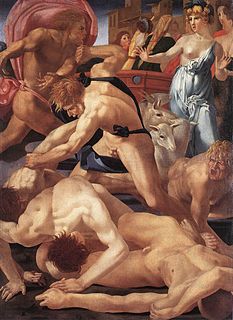 W
WMoses Defends Jethro's Daughters is a c.1523-1524 oil on canvas painting attributed to Rosso Fiorentino, now in the Uffizi in Florence, which acquired it in 1632. It depicts Moses defending the seven daughters of Jethro, his father-in-law.
 W
WMystic Marriage of Saint Catherine or Mystic Betrothal of Saint Catherine is a c.1524 oil on canvas painting, now in the city's Galleria Nazionale. Art historians argue that the work may be attributed to the period in which Parmigianino was painting his first works in the church of San Giovanni Evangelista, as also emerges from a recent restoration, which has shown that its technique is near-identical to that of Parmigianino - "no underdrawing, pigment use, descriptive speed, drafting of final shadows, using fingers and brush-ends as tools".
 W
WMystical Marriage of St Catherine and Saints is an oil painting by Lorenzo Lotto, signed, now in the Collections of the Galleria Nazionale d'Arte Antica, Rome, Italy.
 W
WNoli me tangere is a c. 1525 painting by Correggio of the subject noli me tangere.
 W
WNursing Madonna with an Angel is an oil on panel painting by Correggio, painted around 1524 and now in the Museum of Fine Arts in Budapest. It measures 68.5 by 87 cm and belongs to the Nursing Madonna or 'Madonna Lactans' genre.
 W
WPortrait of Galeazzo Sanvitale (1524) is a painting of the condottiero Gian Galeazzo Sanvitale by the Italian late Renaissance artist Parmigianino. It is housed in the National Museum of Capodimonte, Naples, Italy.
 W
WPortrait of Lorenzo Cybo (1524) is a painting by the Italian late Renaissance artist Parmigianino. It is housed in the Statens Museum for Kunst, Copenhagen, Denmark.
 W
WSaint Michael Defeats the Rebel Angels or Fall of the Rebel Angels is a c.1524 oil on canvas painting by Domenico Beccafumi, now in the Pinacoteca Nazionale di Siena. It was begun for San Niccolò al Carmine, Siena, but left unfinished, with the artist completing another version for the same church in 1526. Vasari's Lives of the Artists mentions the work, stating the artist wished to create "a new invention to show the virtue and good conceits of his soul".
 W
WThe San Martino Nativity is a c.1524 oil on canvas painting by Domenico Beccafumi. It is named after the church of San Martino in Siena, where it still hangs over the altar in the funerary chapel of its commissioner Anastasia Marisli - she died in 1524.
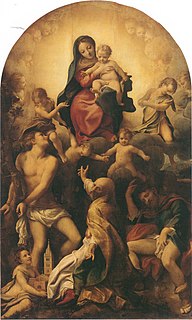 W
WThe San Sebastiano Madonna is an oil on canvas painting by Correggio, dating to around 1524 and now in the Gemäldegalerie Alte Meister in Dresden. It measures 265 by 161 cm.
 W
WSelf-portrait in a Convex Mirror is a painting by the Italian late Renaissance artist Parmigianino. It is housed in the Kunsthistorisches Museum, Vienna, Austria.
 W
WThe Rocca Sanvitale, or Sanvitale Castle, is a fortress residence in the centre of the town of Fontanellato, near Parma, northern Italy. Construction of the moated block, accessible through a drawbridge, was begun in the 13th century, mostly completed by the 15th century, with embellishments continuing through to the 18th century. It is prototypical of the urban castle-houses of the turbulent medieval communes of Northern Italy. Until the 1930s it was the home of the descendants of the Count of Sanvitale.
 W
WThe Suardi Chapel is an oratory or private chapel inside the villa in Trescore Balneario, Province of Bergamo owned by the Suardi counts. It is dedicated to Saint Barbara and Saint Brigid and was completely rebuilt by the cousins Giovan Battista and Maffeo Suardi. It is fully covered in 1524 frescoes commissioned by them from by Lorenzo Lotto of Christ the Vine and Lives of the Saints. In the 19th century count Gianforte Suardi built a corridor connecting the chapel to the villa and modified the chapel entrance - those entering had previously immediately found themselves in front of the north wall with its depiction of Christ the Vine.
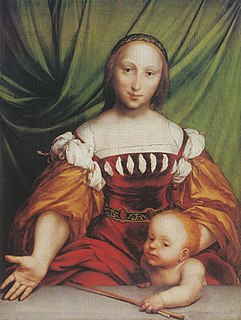 W
WVenus and Amor is a c. 1524 painting by the German painter and printmaker Hans Holbein the Younger, conserved in the Kunstmuseum Basel, Switzerland. Although the work is Holbein's earliest mythological painting, depicting the Roman goddess of love, Venus, with her son Amor (Cupid), the model is believed to be his friend Magdalena Offenburg. They are shown in front of a large hanging green curtain and behind a low parapet. Venus is depicted with an open gesture and sincere gaze. Cupid is seen climbing onto the parapet while holding love's arrow in his left hand. He has red-orange hair, rendered in the same colouring and tone of the rich cloth sleeves covering his mother's upper arms.
 W
WThe Vision of the Cross is a painting made between 1520 and 1524 by assistants of the Italian renaissance artist Raphael. After the master's death in 1520, Gianfrancesco Penni, Giulio Romano and Raffaellino del Colle from Raphael's workshop worked together to finish the commission to decorate with frescoes the rooms that are now known as the Stanze di Raffaello, in the Apostolic Palace in the Vatican.